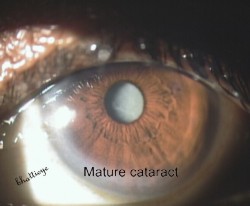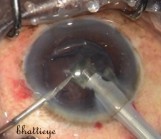The Bhatti Eye Clinic, Mumbai, India
All about cataract , cataract surgery and phacoemulsification
Cataract is the name given to the condition where the natural crystalline lens of the eye turns opaque and blocks light from entering the eye. Since light can no longer easily enter the eye the cataract patient's vision is reduced.
 |
 |
In the early stages the cataract is said to be immature (as seen in the photo on the left) and allows some light through. Later the cataract becomes "mature" and totally opaque. It then appears pearly white in colour within the pupillary area as seen in the photo on the right |
The symptoms of cataract are initially a loss of contrast sensitivity; i.e to say objects that are brightly lit are seen well but the same objects if dimly illuminated are not easily made out. In some types of cataract such as posterior subcapsular cataracts, vision may be more impaired in bright light.
In addition patients may complain of glare,haloes and sometimes double vision.
Treatment of cataract The treatment of cataract is only by surgery. Though many eye drops are marketed which claim to prevent cataract, there is really no universally accepted-to-be-proven medical therapy for cataracts. Some authorities feel that a diet rich in antioxidants may prevent or slow down cataract formation, but once the cataract impairs vision there is really only one alternative- surgical removal of the cataract and its replacement by an intraocular lens.
 |
 |
Surgery for cataracts:
The current state of the art technique for cataract surgery is phacoemulsification with the insertion of a foldable intraocular lens. In this technique an ultrasonic probe is used to emulsify (dissolve) the cataractous nucleus through a 2.8 mm incision. Since the ideal size of the optic part of an intraocular lens is about 6 mm, there are then 2 further choices for insertion of an intraocular lens: either to increase the incision size to 6 mm which defeats the purpose of doing the initial cataract extraction through a 2.8 mm incision, or to insert a foldable lens which can be squeezed down to 2.8 mm for insertion and unfolds to a size of 6 mm inside the eye.The second choice is naturally the preferred choice in most situations.
 phacoemulsification phacoemulsification |
 foldable lens being inserted foldable lens being inserted |
Another state of the art technique for cataract surgery is what is called manual small incision cataract surgery. In this technique the incision size is 6 mm from the start and a rigid PMMA lens can be used. However one stitch must usually be applied to get the best result. This stitch need not be removed. This technique is usually better in cases where phacoemulsification may be suboptimal as in cases with very hard brown cataracts, or with preexisting large cylindrical refractive error.
Both methods of surgery for cataracts are performed as necessary at the Bhatti Eye Clinic, Mumbai, India